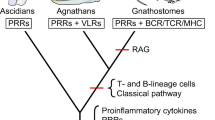Abstract
A highly specific recognition system, capable of distinguishing between allogeneic (non-clonemates) and syngeneic (clonemates) conspecifics, exists in Anemonia sulcata (Coelenterata: Anthozoa). During a competitive interaction between allogeneic individuals, specialized structures (acrorhagi) are exposed and used to sting opponents. This complex behavior is called the acrorhagial response. In order to quantify this behavior we measured the acrorhagial response time (period from first contact with opponent to full expansion of acrorhagi). More than 320 reciprocal histoincompatibility responses were recorded. These histoincompatibility (H) markers are free components of the sea anemone mucus: they were characterized as glyco-proteins of a molecular weight <18 KD (Kilo-Dalton) containing terminal α-d-glucose and/or α-d-mannose. In “alloimmune memory” testing experiments, the “memory trace” in A. sulcata was found to persist for 5 d.
Similar content being viewed by others
Literature cited
Abel, E. F.: Ein Beitrag zųr Giftwirkung der Aktinien und Funktion der Randsäckchen. Zool. Anz. 153, 259–268 (1954)
Ayre, D. J.: Inter-genotype Aggression in the solitary sea anemone Actinia tenebrosa. Mar. Biol. 68, 199–205 (1982)
Bigger, C. H.: The acrorhagial response in Anthopleura krebsi. In: Coelenterate ecology and behavior, pp 127–136. Ed. by G. O. Mackie, Plenum Press: New York and London 1976
Bigger, C. H.: Interspecific and intraspecific acrorhagial aggressive behavior among sea anemones: a recognition of self and notself. Biol. Bull. mar. biol. Lab., Woods Hole 159, 117–134 (1980)
Bigger, C. H., W. H. Hildemann, P. L. Jokiel and I. S. Johnston: Afferent sensitization and efferent cytotoxity in allogeneic tissue responses of the marine sponge. Transplant. 31, 461–464 (1981)
Bigger, C. H., P. L. Jokiel, W. H. Hildemann and I. S. Johnston: Characterization of alloimmune memory in a sponge. J. Immunol. 129, 1570–1572 (1982)
Bigger, C. H., P. L. Jokiel and W. H. Hildemann: Cytotoxin transplantation immunity in the sponge. Transplant. 35, 239–243 (1983)
Bonnin, J.-P.: Recherches sur la “reaction d'aggression” et sur le fonctionnement des acrorhages d'Actinia equina L. Bull. Biol. Fr. Belg. 1, 225–250 (1964)
Brace, R. C. and J. Pavey: Size-dependent dominance hierarchy in the anemone Actinia equina. Nature, Lond. 173, 752–753 (1978)
Courtney Smith, L. and W. H. Hildemann: Alloimmune memory is absent in Hymeniacidon sinapium, a marine sponge. J. Immunol. 133, 2351–2355 (1984)
Francis, L.: Clone specific segregation in the sea anemone Anthopleura elegantissima. Biol. Bull. mar. biol. Lab., Woods Hole 144, 64–72 (1973a)
Francis, L.: Interspecific aggression and its effect on the distribution of Anthopleura elegantissima and some related sea anemones. Biol. Bull. mar. biol. Lab., Woods Hole 144, 73–92 (1973b)
Hildemann, W. H.: Some new concepts in immunological phylogeny. Nature, Lond. 250, 116–120 (1974)
Hildemann, W. H., D. S. Linthicum and D. C. Vann: Immunoin-compatibility reaction in corals (Coelenterata). In: Immunologic phylogeny, pp 105–114. Ed. by W. H. Hildemann and A. A. Benedict. Plenum Press: New York and London 1975
Hildemann, W. H., R. L. Raison, G. Cheung, C. J. Hull, L. Akaka and J. Okamoto: Immunological specificy and memory in a scleractinian coral. Nature, Lond. 270, 219–223 (1977)
Hildemann, W. H., C. H. Bigger and I. S. Johnston: Histoincompatibility reactions and allogeneic polymorphism among invertebrates. Transplant. Proc. 11, 1136–1141 (1979)
Hildemann, W. H., P. L. Jokiel, C. H. Bigger and I. S. Johnston: Allogeneic polymorphism and alloimmune memory in the coral, Montipora verrucosa. Transplant. 30, 297–301 (1980a)
Hildemann, W. H., C. H. Bigger, I. S. Johnston and P. L. Jokiel: Characteristics of transplantation immunity in the sponge. Transplant. 30, 362–367 (1980b)
Lubbock, R.: Clone-specific cellular recognition in a sea anemone. Proc. natl Acad. Sci. USA 77, 6667–6669 (1980)
Ottaway, J. R.: Population ecology of the intertidal anemone Actinia tenebrosa: I. Pedal locomotion and intraspecific aggression. Aust. J. mar. freshwat. Res. 29, 787–802 (1978)
Swank, R. T. and K. D. Munkres: Molecular weight analysis of oligopeptides by electrophoresis in polyacrylanide gel with sodium dodecyl sulfate. Anal. Biochem. 39, 462–477 (1971)
Theodor, J. L.: Distinction between “self” and “not-self” in lower invertebrates. Nature, Lond. 227, 690–692 (1970)
Williams, R. B.: Some recent observations on the acrorhagi of sea anemones. J. mar. biol. Ass. U.K. 58, 787–788 (1978)
Author information
Authors and Affiliations
Additional information
Communicated by O. Kinne, Oldendorf/Luhe
Rights and permissions
About this article
Cite this article
Sauer, K.P., Müller, M. & Weber, M. Alloimmune memory for glycoproteid recognition molecules in sea anemones competing for space. Marine Biology 92, 73–79 (1986). https://doi.org/10.1007/BF00392748
Accepted:
Issue Date:
DOI: https://doi.org/10.1007/BF00392748




